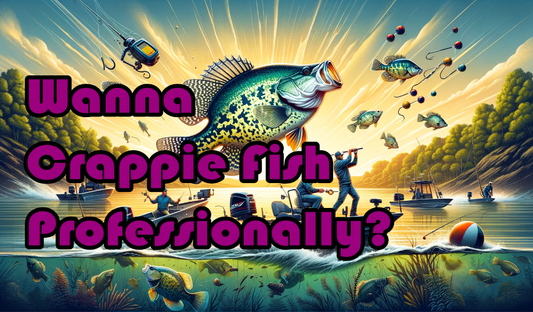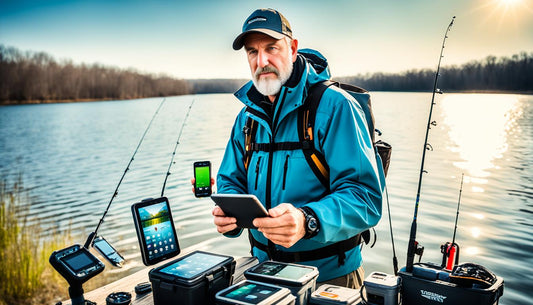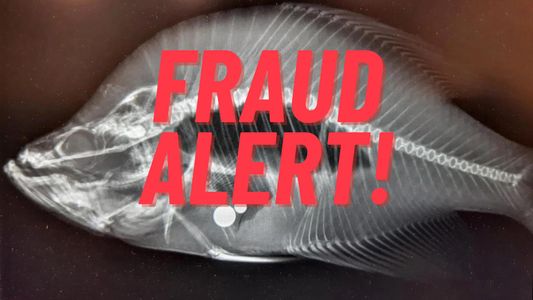Hello, fellow anglers! If you're looking for a thrilling and rewarding fishing experience, look no further than night crappie fishing. Venturing out after dark opens up a whole new world of fishing opportunities, allowing you to test your skills and increase your catch rate. In this guide, I'll reveal the secrets of night crappie fishing and share valuable tips and tricks to make the most of your after-dark angling adventures.

Key Takeaways:
- Explore the exciting world of night crappie fishing for a thrilling and rewarding experience.
- By utilizing specific techniques and strategies, you can increase your chances of success and catch more crappie.
- Discover the best places to find crappie at night, such as shallow cover and deep water suspending.
- Equip yourself with the essential gear for night crappie fishing, including a limber rod and light line.
- Learn about various techniques for catching crappie at night, such as vertical jigging and casting.
Where to Find Crappie at Night
Crappie behavior at night is influenced by their preferred habitats and spawning patterns. During the spring, crappie will move out of deep winter haunts and towards shallow cover to feed and eventually spawn. The exact timing of the spawn varies based on water temperature, with the high 50s being the optimal range. Crappie will spawn in areas such as grass edges, pockets in the grass, stumps, and laydowns. After the spawn, crappie will generally share the job of guarding the nest and fry.
It is also important to note that crappie can suspend in mid-depth cover and deep water, especially during the winter months. Understanding these patterns and locating the right habitats will greatly improve your chances of catching crappie at night.
When targeting nighttime crappie, focus on the following:
- Nighttime crappie habitats: Look for areas with shallow cover, such as grass edges, pockets in the grass, and stumps. These areas provide hiding places for crappie and attract their prey.
- Preferred spawning locations: During the spring, target areas where crappie spawn, such as grass edges, stumps, and laydowns. Crappie will gather in these areas to reproduce, increasing your chances of catching them.
- Deep water suspending: In the winter months, crappie may suspend in mid-depth cover and deep water. Use your fishfinder or depth sounder to locate these suspended crappie and adjust your fishing techniques accordingly.
Pro Tip:
"To find crappie at night, focus on areas with shallow cover and structures such as grass edges, pockets in the grass, stumps, and laydowns. These areas provide hiding places for crappie and attract their prey."
By understanding the preferred habitats and behaviors of crappie at night, you can increase your chances of a successful fishing trip. Now that you know where to find crappie, let's move on to the essential gear you'll need for night crappie fishing.
Essential Gear for Night Crappie Fishing
To effectively target crappie at night, you'll need the right gear. Having the correct equipment ensures you're equipped for success and makes your fishing experience more enjoyable. Here are some essential items you should consider:
1. Crappie Fishing Tackle
Your tackle selection plays a crucial role in night crappie fishing. Using the appropriate gear increases your chances of landing a trophy-sized crappie. Consider the following:
| Tackle | Recommendation |
|---|---|
| Limber Rod | A high-quality 6 to 7-foot spinning rod with a light to medium-light power is ideal for casting or vertical fishing. It offers the necessary sensitivity to detect light bites and flexibility to handle the fight. |
| Spinning Reel | Pair your limber rod with a 1000 or 2000 size spinning reel. This ensures smooth casting and better line control, allowing you to present your bait accurately. |
| Light Line | Opt for light monofilament lines in the range of 4-pound test. Light lines allow your bait to move naturally in the water, increasing its attractiveness to crappie. |
2. Bait Choices
Choosing the right bait is essential in enticing crappie to bite. You have various options, each with its own advantages. Consider these bait choices:
- Crappie Jigs: Crappie jigs on a 1/16-ounce jighead are highly effective for night fishing. Their versatility in terms of color and weight options makes them a go-to choice for many anglers.
- Minnow on a Hook: Using a minnow on a hook with a small split shot weight can also produce excellent results. Crappie find the erratic movements of live bait irresistible.
Experimenting with different bait options is key to finding what works best for you. Adapt your choice based on the prevailing conditions and the behavior of the crappie.
Remember, having the right gear increases your chances of success when night crappie fishing. Invest in quality tackle and bait choices to make the most of your after-dark fishing adventures.
Techniques for Catching Crappie at Night
When it comes to catching crappie at night, there are several techniques that can significantly improve your chances of success. Whether you prefer a slow and steady approach or an active and dynamic style of fishing, there's a technique that suits your preferences. Let's explore some popular methods:
1. Vertical Jigging
Vertical jigging is a tried-and-true technique that involves dropping a jig vertically and using a subtle jigging motion to entice crappie to bite. This method is particularly effective when crappie are holding tight to structures or suspended at a specific depth.
2. Casting
Casting allows you to cover more water and explore different areas in search of active crappie. Simply cast your jig or bait out and retrieve it back to you at a steady pace. This technique is great for targeting crappie near shallow cover or along drop-offs.
3. Trolling
Trolling can be a highly productive technique at night, especially when using minnows or jigs on multiple rods. By slowly moving your boat and dragging your bait behind, you can effectively search for crappie over a larger area. This method is particularly effective when crappie are scattered or feeding in open water.
4. Spider Rigging
Spider rigging involves trolling with multiple rods off the front of the boat, allowing you to cover a larger area and present your baits at various depths. This technique is advantageous when crappie are holding at different depths or spread out over a large area.
5. Shooting Jigs
Shooting jigs is a specialized technique that requires precision and accuracy. It involves shooting the jig into tight spaces, such as under docks or overhanging tree limbs, where crappie seek shelter. This method can be highly effective for targeting crappie in heavy cover.
6. Crankbaits
Fishing with crankbaits can be a great way to target larger crappie in open water. Crankbaits mimic the movements of baitfish, attracting the attention of hungry crappie. Experiment with different sizes, colors, and diving depths to find what entices the crappie in your area.
Each of these techniques has its own charm and can yield great results. It's important to experiment with different methods and adjust your approach based on the conditions and behavior of the crappie. Keep in mind that learning the nuances of each technique takes time and practice, so don't be discouraged if you don't see immediate success. Remember, the thrill of night crappie fishing lies in the journey, so enjoy every moment on the water.
Best Baits for Night Crappie Fishing
When it comes to night crappie fishing, choosing the right bait can make all the difference in attracting these elusive fish. While there is an ongoing debate among anglers about the best baits, there are a few tried-and-true options that consistently produce results. Let me introduce you to some of the top contenders:
1. Live Bait
Live bait is a popular choice among anglers targeting crappie at night. The natural movement and scent of live bait can be highly enticing to these fish. Here are some effective live bait options:
- Minnows
- Crickets
- Mealworms
- Freshwater shrimp
2. Crappie Jigs
Crappie jigs are versatile and effective artificial baits for night fishing. These jigs come in various colors and weights, allowing you to experiment and find the perfect combination that crappie can't resist. I recommend using 2-inch jigs on a 1/16-ounce jighead for optimal results.
3. Crankbaits
To target larger suspended crappie in open water, crankbaits are an excellent choice. Opt for medium diving crankbaits that mimic the movements of baitfish. The lifelike action and vibrations of crankbaits can trigger aggressive strikes from crappie.
4. Jigging Raps and Jerkbaits
In certain situations, jigging raps and jerkbaits can be highly successful in enticing crappie to bite. These lures imitate injured baitfish and can be worked with subtle twitches and jerks to trigger a predator response from crappie. Don't overlook these options when planning your night fishing arsenal.
Experimentation is key when it comes to bait choice. Crappie behavior can vary depending on location, weather conditions, and other factors. By trying different baits and colors, you can find the winning combination that consistently attracts crappie in your fishing spot.
Choosing the Right Lake for Night Crappie Fishing
When it comes to night crappie fishing, selecting the right lake can greatly impact your success. By choosing a lake known for its abundant and sizable crappie population, you'll increase your chances of a productive fishing trip. Conducting lake research and utilizing online resources and topographic maps can provide valuable insights into a lake's crappie population and potential hotspots.
Look for lakes that offer preferred crappie habitats, such as shoreline woody cover, deep water basins, or shallow areas with weed beds, stumps, or fallen logs. These areas often attract crappie and provide ample opportunities for successful night fishing. It's also essential to consider the depth of the lake, as crappie tend to avoid depths exceeding 40 feet.
By taking the time to thoroughly research and select the right lake, you'll significantly improve your chances of having a rewarding night fishing experience.
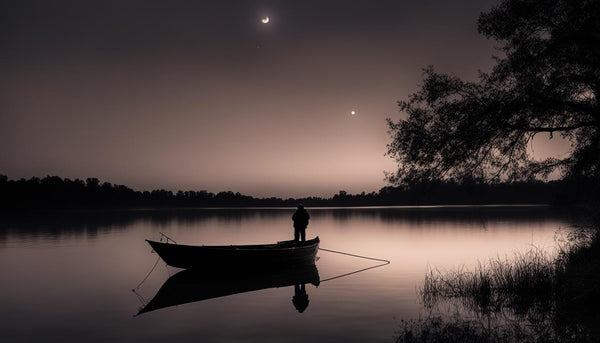
Strategies for Finding Nighttime Crappie
Finding nighttime crappie requires a strategic approach. To increase your chances of success, consider the following strategies:
- Target Early Morning Bite Locations: Begin your search in areas that are known to be productive during the early morning bite. These spots often continue to hold crappie throughout the night.
- Observe Summer Behavior: During the summer months, crappie tend to seek shelter in their preferred habitats, such as shoreline woody cover or deep-water basins. Focus your efforts on these areas to increase your chances of finding crappie.
- Follow Aquatic Insect and Minnow Concentrations: Crappie are opportunistic feeders and are often found in areas with high concentrations of aquatic insects and minnows. By targeting these food sources, you are more likely to encounter crappie.
- Track Late Ice Movement to Shallow Water: As the ice season progresses, crappie may migrate from deeper water to shallower locations, such as weed beds, stumps, or fallen logs. Stay updated on the movement patterns of crappie during this time to optimize your fishing strategies.
Adapting your fishing strategies based on seasonal behaviors and focusing on areas with high activity and food sources will greatly enhance your chances of finding nighttime crappie.

Reading the Ice for Night Crappie Fishing
When it comes to night crappie fishing, reading the ice can be a valuable skill that helps you find productive spots. By paying attention to the ice conditions and observing evidence on the ice, you can increase your chances of success. Here are some key factors to consider:
Ice Conditions
Before venturing out onto the ice, ensure that it is safe and thick enough to support your weight. Check for any cracks or areas of thin ice that could pose a risk. Always prioritize your safety when ice fishing.
Evidence on the Ice
Look for clues that indicate recent fishing activity on the ice. Keep an eye out for hole patterns, which can indicate areas where other anglers have been successful. You may also come across blood stains, discarded bait containers, or footprints left behind by fellow fishermen. These signs can help you identify active fishing areas.
Crowded Areas
While it may be tempting to fish in areas with a high concentration of anglers, keep in mind that crowded spots can lead to increased noise levels. This noise can potentially scare off the crappie you're targeting. Consider exploring quieter areas or moving away from crowded spots to increase your chances of success.
By utilizing these tips and paying attention to the ice conditions and evidence on the ice, you'll be better equipped to find productive crappie spots for your night fishing adventures.

Nighttime Ice Fishing Safety Precautions
Nighttime ice fishing can be an exhilarating and peaceful experience, but it's important to prioritize safety to ensure a successful outing. Here are some essential safety precautions and night fishing essentials to keep in mind:
1. Essential Safety Gear
Before heading out onto the ice, make sure to bring along essential safety gear. These items can be vital in case of an emergency:
- Ice picks: Carry a set of ice picks to help you pull yourself out of the water if you were to fall through the ice.
- Throw rope: Keep a throw rope handy to assist in rescuing someone who may have fallen through the ice.
- Flotation device: Wearing a flotation device, such as a life jacket or a float suit, can provide added safety in case of an accident.
2. Proper Lighting
Having adequate lighting is essential for navigating the ice safely, especially during nighttime fishing. Here are some important lighting essentials to consider:
- Headlamps: A headlamp is a hands-free lighting option that allows you to see where you're walking on the ice.
- Flashlights: Carry a few reliable flashlights to illuminate your surroundings and to signal for help if needed.
- Lanterns: Lanterns can provide a wide area of illumination, making them useful for setting up your fishing spot or campsite.
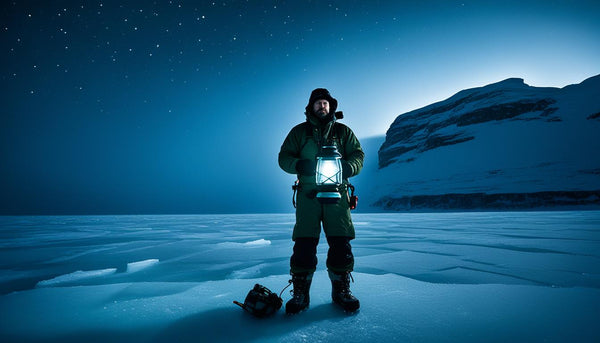
3. Warm Clothing
Staying warm and dry is crucial when ice fishing at night, as the temperatures can drop significantly. Here are some tips for dressing appropriately:
- Layer up: Wear multiple layers of clothing, including thermal underwear, insulating mid-layers, and a waterproof outer layer.
- Insulated footwear: Invest in insulated boots to keep your feet warm and protected from the cold ice.
- Gloves and hats: Don't forget to wear insulated gloves or mittens and a warm hat to retain body heat.
4. Ice Safety Gear
Prior to venturing onto the ice, it's essential to assess the ice conditions and be prepared for any potential hazards. Here's what you need to know:
- Check ice thickness: Always check the ice thickness with an ice auger or a spud bar before walking or driving on it. The ice should be at least 4 inches thick for a single person and thicker for large groups or vehicles.
- Look for warning signs: Be cautious of any signs of cracks, pressure ridges, or areas with thin ice. Avoid fishing near areas with flowing water, as the ice may be weaker.
- Stay informed: Stay updated on local ice conditions and weather forecasts before heading out. This information can help you make informed decisions about where and when to fish.
By following these safety precautions and having the necessary equipment, you can enjoy a safe and successful nighttime ice fishing adventure. Stay prepared, stay alert, and make the most of your time on the ice!
Setting up Your Boat for Night Crappie Fishing
Nighttime crappie fishing from a boat requires proper setup to ensure convenience and safety. To make the most of your after-dark angling adventures, here are some essential steps to follow in setting up your boat:
1. Organize Your Equipment
Arrange your equipment in an organized manner to have everything easily accessible during your fishing trip. Make sure to include your bait, tackle, and safety gear. Having a well-organized setup will save you time and effort, allowing you to focus on catching crappie.
2. Install Rod Holders
Installing rod holders on your boat is a smart move to keep your rods secure and within reach. With rod holders, you can easily switch between rods or keep them safely stowed when not in use. This allows for a more efficient fishing experience and prevents any accidental damage to your valuable fishing gear.
3. Ensure Proper Lighting
Proper lighting is essential for both navigation and fishing purposes during night crappie fishing. Consider adding spotlights, navigation lights, and LED boat lights to enhance visibility on the water. Not only will this help you navigate safely, but it will also improve your chances of locating and attracting crappie.
4. Accessible Safety Equipment
Always prioritize safety on your boat. Ensure that all safety equipment, such as life jackets, fire extinguishers, and signaling devices, are easily accessible. This ensures that you are prepared for any potential emergencies or unforeseen circumstances while out on the water.
Setting up your boat correctly for night crappie fishing maximizes your efficiency and ensures a safe and enjoyable fishing experience. By organizing your equipment, installing rod holders, ensuring proper lighting, and having accessible safety equipment, you'll be fully prepared for your after-dark angling adventures.
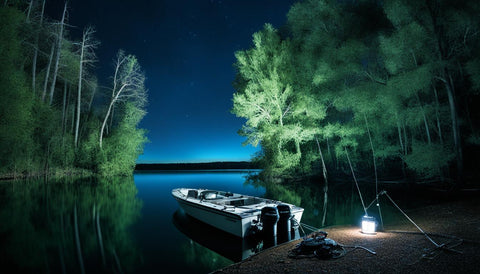
Note: This table showcases the recommended placement of fishing equipment on a boat for night crappie fishing. Ensure that all equipment is stowed securely and easily accessible during your fishing trip.
Conclusion
Night crappie fishing is an exhilarating and fulfilling adventure that offers a unique angling experience. By employing effective night crappie fishing techniques, you can greatly increase your chances of a successful fishing trip. Understanding the habitats and behaviors of crappie, equipping yourself with the right gear, and employing strategic fishing methods are key to improving your catch rate.
It is important to prioritize safety when venturing out for after-dark angling adventures. Taking the necessary precautions and setting up your boat correctly will ensure a safe and enjoyable experience. By following safety guidelines and being prepared with the appropriate night fishing essentials, you can focus on reeling in those crappie without any worries.
So, gear up and get ready for the thrill of night crappie fishing. Armed with the knowledge of their preferred habitats and feeding patterns, the right gear, and a strategic approach, you'll be on your way to enhancing your catch rate and creating unforgettable after-dark angling adventures. Enjoy the mystery and excitement that night crappie fishing brings and make the most of every cast!
FAQ
What are some effective techniques for catching crappie at night?
Some effective techniques for catching crappie at night include vertical jigging, casting, trolling, spider rigging, shooting jigs, and fishing with crankbaits. Experiment with these techniques to find what works best for you and the conditions you're fishing in.
What are the best baits for night crappie fishing?
The best baits for night crappie fishing include live bait options like minnows, crickets, mealworms, freshwater shrimp, as well as crappie jigs, crankbaits, jigging raps, jerkbaits, and tiny jigging spoons. Experiment with different baits and colors to determine what works best in your fishing location.
How can I choose the right lake for night crappie fishing?
To choose the right lake for night crappie fishing, do online research and consult topographic maps to gather information about the lake's crappie population and potential hotspots. Look for lakes with preferred crappie habitats such as shoreline woody cover, deep water basins, or shallow areas with weed beds, stumps, or fallen logs.
Where can I find crappie at night?
Crappie can be found at night in their preferred habitats, such as shoreline woody cover, deep-water basins, and shallow areas with weed beds, stumps, or fallen logs. Keep an eye out for concentrations of aquatic insects and minnows, as crappie will often be nearby.
What safety precautions should I take for nighttime ice fishing?
For nighttime ice fishing, make sure to bring essential safety gear such as ice picks, a throw rope, and a flotation device. Have proper lighting including headlamps, flashlights, and lanterns. Dress in warm and waterproof clothing and always check the ice conditions before venturing out. Be aware of any potential hazards such as cracks or thin ice.
How should I set up my boat for night crappie fishing?
To set up your boat for night crappie fishing, arrange your equipment in an organized manner and install rod holders to keep your rods secure and easily accessible. Ensure you have proper lighting for navigation and fishing, such as spotlights, navigation lights, and LED boat lights. Also, make sure all safety equipment like life jackets, fire extinguishers, and signaling devices are easily accessible.

